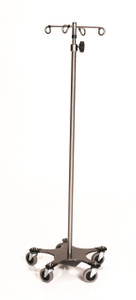 Loading... Please wait...
Loading... Please wait...Free Shipping on orders over $400
- Home
- Medical Equipment
- Stainless Steel IV Pole with Five Leg Base
Categories
Stainless Steel IV Pole with Five Leg Base
Product Description
Stainless Steel IV Pole with Five Leg Base
Important Note: This product is oversized/heavy weight and is not covered under our Free Shipping option. This product has an additional shipping fee for shipping in the contiguous USA. Shipping outside the contiguous USA will be calculated when we process the order. Contact us if you have any questions.
IV Pole Intro
IV poles, also known as intravenous poles, are crucial medical devices used to hang IV bags and medical equipment in healthcare settings. They come in various configurations, with considerations for the top hooks, pole strength and cleanliness, accessories, and base support.
Most poles are made of chrome-plated steel or stainless steel. Chrome-plated steel is cost-effective but may rust if damaged or worn thin. Stainless steel is more durable, corrosion and moisture resistant. Some types of stainless steel will react to a magnetic field. Only use an MRI Certified IV Pole around an MRI.
Most IV poles have a locking feature to secure the height adjustment. You turn a knob to release the pressure and adjust the height, then turn it the other way to lock the poles together. There are also foot-controlled locks (MCM290).
Lift Assist Poles (MCM-251, 252 & 253) have up to 28 hooks for large bags, allowing you to mount bags and adjust their height with ease, designed for heavy bags.
There are light-duty, medium-duty, and heavy-duty IV poles, with heavier duty IV poles having larger pole diameters and bases for increased load capacity and stability. Accessories can affect stability and pole lifespan, so medium and heavy-duty poles are recommended for long-term use.
Consider wheel size for increased mobility; 3-inch wheels are better for uneven floors or areas with cracks to roll over. MRI Certified IV Poles are required in MRI environments.
Shipping varies, with light and medium-duty poles shipped by UPS or FedEx Ground, and heavy-duty poles shipped by truck with potential additional costs. Customers will be informed of shipping estimates for heavy-duty orders.
- 16" diameter space saving base decreases obstruction in the operating room where floor space is essential
- Base weighs 21 pounds for unmatched stability and comes with 3" scuff-resistant casters
- Pole sections and top are stainless steel. Top is detachable.
- Height adjustable from 52"—94" by simply turning the soft touch “no lose” friction knob
- Standard base color is charcoal. Other base colors available upon request. (R=red, G=green, Y=yellow, B=blue)
- Ideal for departmentalizing
- Available with a 2, 4, or 6 hook tops
- Manufacturer: Mid Central Medical
Cleaning and maintenance
The surfaces of both chrome plated and stainless steel are subject to discoloration and staining. The best maintenance is to clean them with a diluted simple soap and rinse with a clean water then wipe it dry.
Any moving or parts that rub together should be lubricated as recommended by the manufacturer.
Wheels should be inspected, and anything wrapped around the wheel should be removed. Some wheels need lubrication and others do not. Check with the manufacturer as to the instructions.
Sterilization is not normally needed for most stainless steel equipment since it is usually not in direct contact with surgical instruments, but you can check with the manufacturer to find out what wipes or procedures should be used for sterilization.
After stainless steel has been cleaned, you may want to disinfect it before use. This is best done with disposable wipes not containing chlorine bleach. If bleach wipes are used, you will need to do a final rinse with clean water to remove the bleach residue as it will cause the stainless steel to have a cloudy finish or white residue over time. We recommend using Super Sani-Cloth Germicidal Disposable Wipes to disinfect stainless steel medical equipment.












